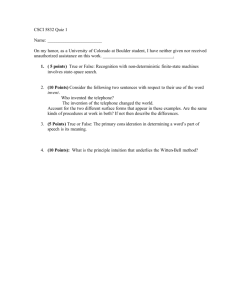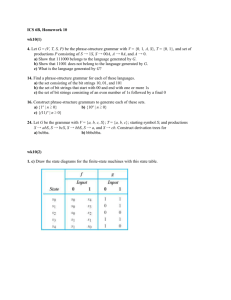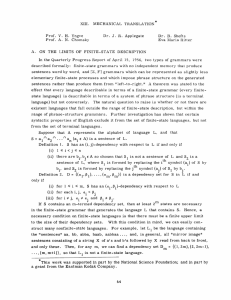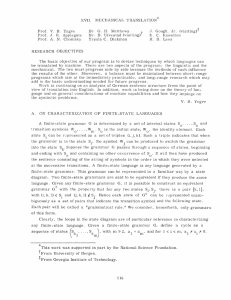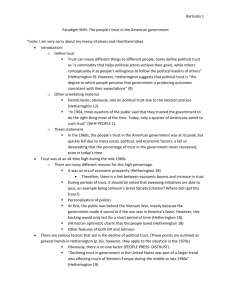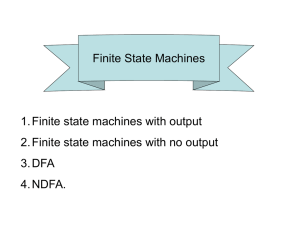Finite-State • – Lecture # 17
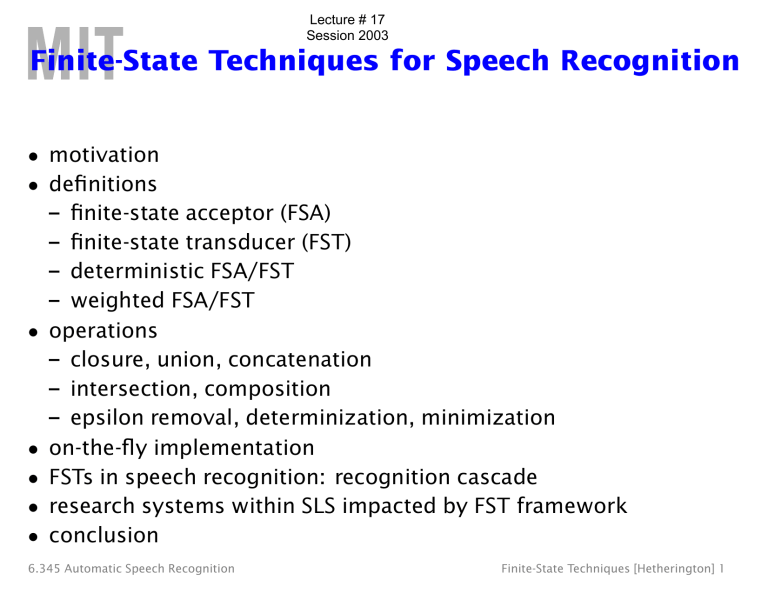
Lecture # 17
Session 2003
Finite-State Techniques for Speech Recognition
• motivation
• definitions
– finite-state acceptor (FSA)
– finite-state transducer (FST)
– deterministic FSA/FST
– weighted FSA/FST
• operations
– closure, union, concatenation
– intersection, composition
– epsilon removal, determinization, minimization
• on-the-fly implementation
• FSTs in speech recognition:recognition cascade
• research systems within SLS impacted by FST framework
• conclusion
6.345
Automatic Speech Recognition Finite-State Techniques [Hetherington] 1
Motivation
• many speech recognition components/constraints are finite-state
– language models (e.g., n -grams, on-the-fly CFGs)
– lexicons
– phonological rules
– N -best lists
– word graphs
– recognition paths
• should use same representation and algorithms for all
– consistency
– make powerful algorithms available at all levels
– flexibility to combine or factor in unforeseen ways
• AT&T [Pereira, Riley, Ljolje, Mohri, et al.]
6.345
Automatic Speech Recognition Finite-State Techniques [Hetherington] 2
Finite-State Acceptor (FSA) b a
0
ε a
1 2 accepts ( a | b )
∗ ab b
3
• definition:
– finite number of states
– one initial state
– at least one final state
– transition labels:
∗ label from alphabet Σ must match input symbol
∗ consumes no input
• accepts a regular language
6.345
Automatic Speech Recognition Finite-State Techniques [Hetherington] 3
Finite-State Transducer (FST) b:a a:b
0
ε
:
ε a:
ε
1 2 e.g., ( aba ) a → ( bab ) a
ε
:a
3
• definition, like FSA except:
– transition labels:
∗ pairs of input:output labels
∗ on input consumes no input
∗ on output produces no output
• relates input sequences to output sequences (maybe ambiguous)
• FST with labels x : x is an FSA
6.345
Automatic Speech Recognition Finite-State Techniques [Hetherington] 4
Finite-State Transducer (FST)
• final states can have outputs, but we use transitions instead
0 a:b
1 b
0 a:b
1
ε
:b
2
• transitions can have multiple labels, but we split them up a,b:a
0 1 c:b,c
2
0 a:a
1 b:b
2 c:c
3
6.345
Automatic Speech Recognition Finite-State Techniques [Hetherington] 5
Weights
0 a/0.6 a/0.4
1 b/0.7 b/0.3
2/0.5
• transitions and final states can have weights (costs or scores)
• weight semirings ( ⊕ , ⊗ , 0 , 1 ) , ⊕ ∼ parallel, ⊗ ∼ series:
– 0 ⊕ x = x , 1 ⊗ x = x , 0 ⊗ x = 0 , 0 ⊗ 1 = 0
– (+ , × , 0 , 1) ∼ probability (sum parallel, multiply series) a/1 b/1
0 1 2/0.5
ab/ 0 .
5
– ( min , + , ∞ , 0) ∼ − log probability (best of parallel, sum series) a/0.4 b/0.3
0 1 2/0.5
ab/ 1 .
2
6.345
Automatic Speech Recognition Finite-State Techniques [Hetherington] 6
Deterministic FSA or FST
• input sequence uniquely determines state sequence
• no transitions
• at most one transition per label for all states a
ε a
0 1 non-deterministic (NFA) a a
0 1
2 deterministic (DFA)
6.345
Automatic Speech Recognition Finite-State Techniques [Hetherington] 7
Operations
• constructive operations:
– closure A
∗ and A +
– union A ∪ B
– concatenation AB
– complementation A
– intersection A ∩ B
– composition A ◦ B
• identity operations (optimization):
– epsilon removal
– determinization
– minimization
6.345
Automatic Speech Recognition
(FSA only)
(FSA only)
(FST only, FSA ≡ ∩ )
Finite-State Techniques [Hetherington] 8
Closure: A , A
∗
A =
0 a b
1
2
A + =
A
∗
=
0 b
ε a
ε
1
2
0 b
ε a
ε
1
2
6.345
Automatic Speech Recognition Finite-State Techniques [Hetherington] 9
Union: A ∪ B parallel combination, e.g.,
0 a 1
ε b
2
∪ 0 c d
1
=
0
ε
ε a
1
2 c d
3
ε b
4
5
6.345
Automatic Speech Recognition Finite-State Techniques [Hetherington] 10
Concatenation: AB serial combination, e.g.,
=
0 a b
1
2
0 c d
1
0 a b
1
2
ε
ε
3 c d
4
6.345
Automatic Speech Recognition Finite-State Techniques [Hetherington] 11
FSA Intersection: A ∩ B
• output states associated with input state pairs ( a, b )
• output state is final only if both a and b are final
• transition with label x only if both a and b have x transition
• weights combined with ⊗ x x z
0 x y
1
∩
0 y
1 x x (1,0)
=
(0,0) y
⇒ x
∗
( x | y ) ∩ x
∗ yz
∗
= x
∗ y
(1,1)
6.345
Automatic Speech Recognition Finite-State Techniques [Hetherington] 12
FST Composition: A ◦ B
• output states associated with input state pairs ( a, b )
• output state is final only if both a and b are final
• transition with label x : y only if a has x : α and b has α : y transition
• weights combined with ⊗
/ih/:[ih]
/t/:[t]
IT:/ih/
ε
:/t/
0 1 2
◦
0
/t/:[tcl]
ε
:[t]
1
ε
:[t]
= (0,0)
IT:[ih]
(1,0)
ε
:[tcl]
ε
:[t]
(2,0)
(2,1)
• (words → phonemes) ◦ (phonemes → phones) = (words → phones)
6.345
Automatic Speech Recognition Finite-State Techniques [Hetherington] 13
FST Composition: Interaction
• A output allows B to hold
• B input allows A to hold a:
ε
0 1
◦ a:
ε (1,0)
=
(0,0) a:b
ε
:b
(0,1)
0
ε
:b a:
ε
ε
:b•
(1,1)
1
• multiple paths typically filtered (resulting in dead end states)
6.345
Automatic Speech Recognition Finite-State Techniques [Hetherington] 14
FST Composition: Parsing
• language model from JSGF grammar compiled into on-the-fly recursive transition network (RTN) transducer G :
<top> = <forecast> | <conditions> | ...
;
<forecast> = [what is the] forecast for <city> {FORECAST};
<city> = boston [massachusetts] {BOS}
| chicago [illinois] {ORD};
• “what is the forecast for boston’’ ◦ G →
– BOS FORECAST output tags only
– < forecast > what is the forecast for < city > boston < /city >
< /forecast > bracketed parse
6.345
Automatic Speech Recognition Finite-State Techniques [Hetherington] 15
FST Composition Summary
• very powerful operation
• can implement other operations:
– intersection
– application of rules/transformations
– instantiation
– dictionary lookup
– parsing
6.345
Automatic Speech Recognition Finite-State Techniques [Hetherington] 16
Epsilon Removal (Identity)
• required for determinization
• compute -closure for each state:set of states reachable via
∗ a c
0
ε
1 a
ε c b
2
⇒
0 b b c
1
• can dramatically increase number of transitions (copies)
6.345
Automatic Speech Recognition Finite-State Techniques [Hetherington] 17
FSA Determinization (Identity)
• subset construction
– output states associated with subsets of input states
– treat a subset as a superposition of its states
• worst case is exponential ( 2 N
)
• locally optimal:each state has at most | Σ | transitions a a a
0 a
1
⇒ a 1 b b
0 b
• weights:subsets of (state, weight)
– weights might be delayed
– transition weight is ⊕ subset weights
– worst case is infinite (not common) a
2
6.345
Automatic Speech Recognition Finite-State Techniques [Hetherington] 18
FST Determinization (Identity)
• subsets of (state, output
∗
, weight)
• outputs and weights might be delayed
• transition output is least common prefix of subset outputs
/t/:TWO
1
/uw/:
ε
0 /t/:TEA /iy/:
ε
3
2
⇓
(0,
ε
)
/t/:
ε
(1,TWO)
(2,TEA)
/uw/:TO
/iy/:TEA
(3,
ε
)
• worst case is infinite (not uncommon due to ambiguity)
6.345
Automatic Speech Recognition Finite-State Techniques [Hetherington] 19
FST Ambiguity
• input sequence maps to more than one output (e.g., homophones)
• finite ambiguity (delayed to output states):
0
0 a:
ε a:x a:y
1
1
2
⇓ b:
ε b:
ε b:
ε
2
3
ε
:x
ε
:y
3
6.345
Automatic Speech Recognition Finite-State Techniques [Hetherington] 20
FST Ambiguity
• cycles (e.g., closure) can produce infinite ambiguity
• infinite ambiguity (cannot be determinized): a:x
0 a:y b:
ε
1
• a solution:our implementation forces outputs at #, a special a:x
0 a:y
1 b:
ε
#:
ε
2
6.345
Automatic Speech Recognition
0 a:
ε 1
#:x
#:y b:
ε
2
Finite-State Techniques [Hetherington] 21
Minimization (Identity)
• minimal ≡ minimal number of states
• minimal ≡ deterministic with minimal number of states
• merge equivalent states, will not increase size
• cyclic O ( N log N ) , acyclic O ( N )
/s/:BOSTON
5
/t/:
ε
8
/ax/:
ε
11
0
/b/:
ε
/ao/:AUSTIN
1
/ao/:
ε
3
/z/:BOSNIA
6
/n/:
ε
9
/iy/:
ε
12
/s/:
ε
/t/:
ε
/ax/:
ε
/n/:
ε
2 4 7 10 13
/n/:
ε
/ax/:
ε
14
15
0
/b/:
ε
/ao/:AUSTIN
1
/ao/:
ε
2
3
/s/:
ε
/z/:BOSNIA
/s/:BOSTON
5
4
/n/:
ε
/t/:
ε
7
6
/iy/:
ε
/ax/:
ε
9
8
/ax/:
ε
/n/:
ε
10
6.345
Automatic Speech Recognition Finite-State Techniques [Hetherington] 22
Example Lexicon
0
ε
:
ε
ε
:
ε
ε
:
ε
ε
:
ε
ε
:
ε
ε
:
ε
ε
:
ε
ε
:
ε
ε
:
ε
ε
:
ε
ε
:
ε
ε
:
ε
ε
:
ε
ε
:
ε
ε
:
ε
ε
:
ε
ε
:
ε
1
2
3
4
5
6
7
8
9
10
11
12
13
14
15
16
17 z:zinc
18 z:zillions z:zigzag
19
20 z:zest z:zeroth
21
22 z:zeros
23 z:zeroing z:zeroes
24
25 z:zeroed z:zero
26
27 z:zenith
28 z:zebras z:zebra
29
30 z:zealousness
31 z:zealously
32 z:zealous
33 z:zeal
34 r:
ε r:
ε r:
ε r:
ε r:
ε n:
ε l:
ε g:
ε s:
ε a:
ε a:
ε a:
ε a:
ε r:
ε n:
ε b:
ε b:
ε
52
53
54
55
56
57
58
59
60
61
62
63
64
65
66
67
68 o:
ε i:
ε r:
ε r:
ε l:
ε l:
ε l:
ε l:
ε o:
ε o:
ε o:
ε o:
ε o:
ε c:
ε l:
ε z:
ε t:
ε e:
ε e:
ε e:
ε e:
ε e:
ε e:
ε e:
ε e:
ε e:
ε e:
ε e:
ε e:
ε e:
ε i:
ε e:
ε i:
ε i:
ε
35
36
37
38
39
40
41
42
43
44
45
46
47
48
49
50
51
69
70
71
72
73
74
75
76
77
78
79
80
81
82
83
84
85 i:
ε a:
ε t: e: e:
ε s:
ε i:
ε
ε
ε
86
87
88
89
90
91
92 t:
ε a:
ε a:
ε o:
ε o:
ε o:
ε
93
94
95
96
97
98 o:
ε g:
ε h:
ε
101 n:
ε s:
ε d:
ε
99
100
102
103
104 h:
ε s:
ε
105
106 u:
ε u:
ε u:
ε
107
108
109 n:
ε
110 s:
ε
115 g:
ε s:
ε s:
ε s:
ε
111
112
113
114 n:
ε l:
ε
116
117 e:
ε y:
ε
118
119 s:
ε
120 s:
ε
121
6.345
Automatic Speech Recognition Finite-State Techniques [Hetherington] 23
Example Lexicon: Removed
0 z:zinc z:zillions z:zigzag z:zest z:zeroth z:zeros z:zeroing z:zeroes z:zeroed z:zero z:zenith z:zebras z:zebra z:zealousness z:zealously z:zealous z:zeal
1
2
3
4
5
6
7
8
9
10
11
12
13
14
15
16
17 e:
ε e:
ε e:
ε e:
ε e:
ε e:
ε e:
ε i:
ε i:
ε i:
ε e:
ε e:
ε e:
ε e:
ε e:
ε e:
ε e:
ε
18
19
20
21
22
23
24
25
26
27
28
29
30
31
32
33
34 r:
ε r:
ε r:
ε r:
ε r:
ε r:
ε n:
ε n:
ε l:
ε g:
ε s:
ε a:
ε a:
ε a:
ε b:
ε b:
ε a:
ε
35
36
37
38
39
40
41
42
43
44
45
46
47
48
49
50
51 l:
ε l:
ε l:
ε i:
ε r:
ε r:
ε l:
ε o:
ε o:
ε o:
ε o:
ε o:
ε o:
ε c:
ε l:
ε z:
ε t:
ε
88
52
53
89
54
55
56
57
58
90
59
60
61
62
63
64
91 i:
ε a:
ε t:
ε s:
ε i:
ε e:
ε e:
ε
67
92
70
68
69
65
66 o:
ε g:
ε h:
ε n:
ε s:
ε d:
ε
76
94
95
77
96
97 t:
ε a:
ε a:
ε o:
ε o:
ε o:
ε
71
72
93
73
74
75 h:
ε s:
ε
98
99 u:
ε u:
ε u:
ε
78
79
80 n:
ε
81 g:
ε
100 s:
ε s:
ε s:
ε s:
ε
82
83
101 n:
ε l:
ε
102
84
85 e:
ε y:
ε
86
103 s:
ε
87 s:
ε
104
6.345
Automatic Speech Recognition Finite-State Techniques [Hetherington] 24
Example Lexicon: Determinized
0 z:
ε
1 i:
ε 2 n:zinc l:zillions g:zigzag
4
5
6 e:
ε
3 c:
ε l:
ε z:
ε
12
13
14 i:
ε
15 n:zenith
7 s:zest r:
ε b:
ε a:
ε
8 t:
ε o:
ε
16
17 9
10 r:
ε
18
11 l:
ε
19 i:
ε a:
ε t:
ε
ε
:zero
20
21
22
48 i:zeroing e:
ε s:zeros t:zeroth
23
24
25
26 a:
ε
27
ε
:zeal o:
ε
49
28 o: g: h: n:
ε s:zeroes d:zeroed h:
ε
ε
ε
ε
ε
:zebra s:zebras u:
ε
31
34
35
50
29
30
32
33
36
37 n:
ε
38 g:
ε
39 s:
ε
40 s:
ε
41
ε
:zealous n:zealousness l:zealously
51
42
43 e:
ε y:
ε
44
45 s:
ε
46 s:
ε
47
• lexical tree
• sharing at beginning of words:can prune many words at once
6.345
Automatic Speech Recognition Finite-State Techniques [Hetherington] 25
Example Lexicon: Minimized
0 z:
ε
1 e:
ε a:
ε i:
ε
11
3 s:zest n:zenith r:
ε b:
ε 9
8
10 l:
ε
17 o:
ε
2 n:zinc l:zillions g:zigzag
5
24 u:
ε
26 l:
4
ε
12
6 s:
ε
28 z:
ε i:
ε n:zealousness
18
29 l:zealously
13
ε
:zeal
7 i:
ε
14 o:
ε r:
ε t:
ε t:
ε
15 c:
ε o: e: a:
ε
ε
ε i:zeroing t:zeroth
25
31
ε
:zealous
21
20 e:
ε n: s:
30 n:
ε
ε
ε s:zeros
ε
:zero a:
ε
16
27 y:
ε
19 h:
ε
22 d:zeroed s:zeroes
32
23
ε s: g:
ε
ε
:zebra s:zebras
• sharing at the end of words
6.345
Automatic Speech Recognition Finite-State Techniques [Hetherington] 26
On-The-Fly Implementation
• lazy evaluation:generate only relevant states/transitions
• enables use of infinite-state machines (e.g., CFG)
• on-the-fly:
– composition, intersection
– union, concatenation, closure
– removal, determinization
• not on-the-fly:
– trimming dead states
– minimization
– reverse
6.345
Automatic Speech Recognition Finite-State Techniques [Hetherington] 27
FSTs in Speech Recognition
• cascade of FSTs:
( S ◦ A ) ◦ ( C ◦ P ◦ L ◦ G )
R
– S :acoustic segmentation*
– A :application of acoustic models*
– C :context-dependent relabeling (e.g., diphones, triphones)
– P :phonological rules
– L :lexicon
– G :grammar/language model (e.g., n -gram, finite-state, RTN)
6.345
Automatic Speech Recognition Finite-State Techniques [Hetherington] 28
FSTs in Speech Recognition
• in practice:
– S ◦ A is acoustic segmentation with on-demand model scoring
– C ◦ P ◦ L ◦ G :precomputed and optimized or expanded on the fly
– composition S ◦ A with C ◦ P ◦ L ◦ G computed on demand during forward Viterbi search
– might use multiple passes, perhaps with different G
• advantages:
– forward search sees a single FST R = C ◦ P ◦ L ◦ G , doesn’t need special code for language models, lexical tree copying, etc.
.
.
– can be very fast
– easy to do cross-word context-dependent models
6.345
Automatic Speech Recognition Finite-State Techniques [Hetherington] 29
N -gram Language Model ( G ): Bigram in/1.2 in/3.3 in ε
/8.2 in/8.7
Boston/2.8
*
Boston/4.3
ε
/7.2
Nome/6.3
Boston
ε
/3.2
Nome
• each distinct word history has its own state
• direct transitions for each existing n -gram
• transitions to back-off state (*), removal undesirable
6.345
Automatic Speech Recognition Finite-State Techniques [Hetherington] 30
Phonological Rules ( P )
• segmental system needs to match explicit segments
• ordered rules of the form:
{V SV} b {V l r w} => bcl [b] ;
{m} b {} => [bcl] b ;
{} b {} => bcl b ;
{s}
{} s {} s {}
=> [s]
=> s
;
;
• rule selection deterministic, rule replacement may be ambiguous
• compile rules into transducer P = P l
◦ P r
– P l applied left-to-right
– P r applied right-to-left
6.345
Automatic Speech Recognition Finite-State Techniques [Hetherington] 31
EM Training of FST Weights
• FSA A x given set of examples x
– straightforward application of EM to train P ( x )
– our tools can also train an RTN (CFG)
• FST T x : y given set of example pairs x : y
– straightforward application of EM to train T x,y
– T x | y
= T x,y
◦ det ( T y
)
− 1 ⇒ P ( x | y )
⇒ P ( x, y )
[Bayes’ Rule]
• FST T x | y within cascade S v | x
◦ T x | y
◦ U z given v : z
– x = v ◦ S
– y = U ◦ z
– train T x | y given x : y
• We have used these techniques to train P , L , and ( P ◦ L ) .
6.345
Automatic Speech Recognition Finite-State Techniques [Hetherington] 32
Conclusion
• introduced FSTs and their basic operations
• use of FSTs throughout system adds consistency and flexibility
• consistency enables powerful algorithms everywhere
(write algorithms once)
• flexibility enables new and unforeseen capabilities
(but enables you to hang yourself too)
• SUMMIT (Jupiter) 25% faster when converted to FST framework, yet much more flexible
6.345
Automatic Speech Recognition Finite-State Techniques [Hetherington] 33
References
• E.
Roche and Y.
Schabes (eds.), Finite-State Language Processing ,
MIT Press, Cambridge, 1997.
• M.
Mohri, “Finite-state transducers in language and speech processing,’’ in Computational Linguistics , vol.
23, 1997.
• M.
Mohri, M.
Riley, D.
Hindle, A.
Ljolje, F.
Pereira, “Full expansion of context-dependent networks in large vocabulary speech recognition’’, in Proc.
ICASSP, Seattle, 1998.
6.345
Automatic Speech Recognition Finite-State Techniques [Hetherington] 34
